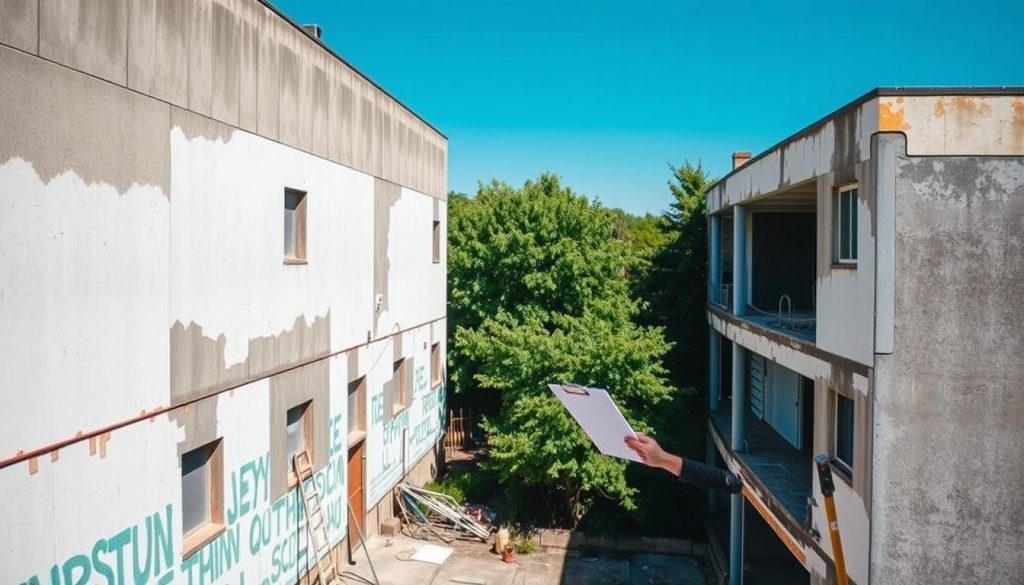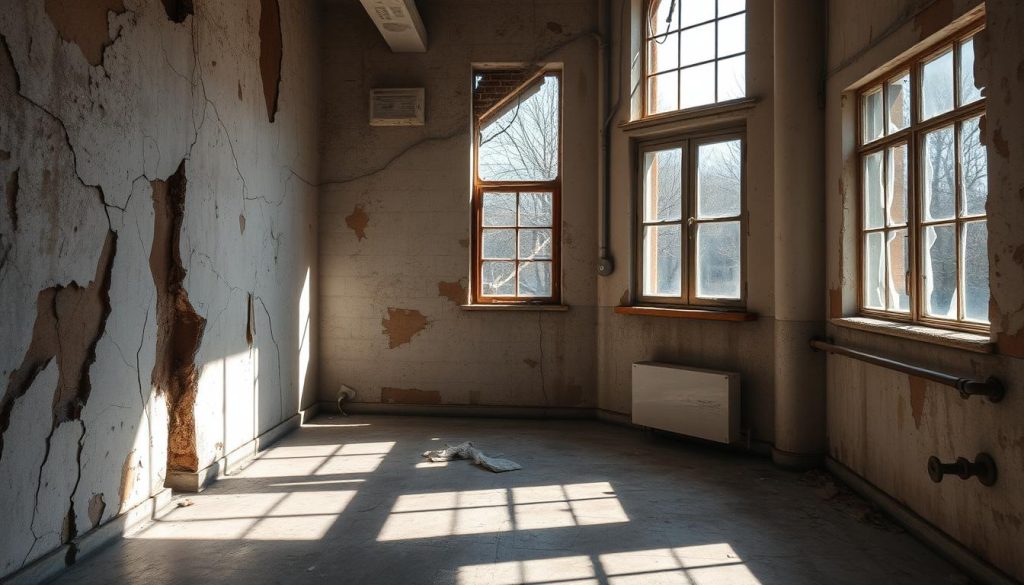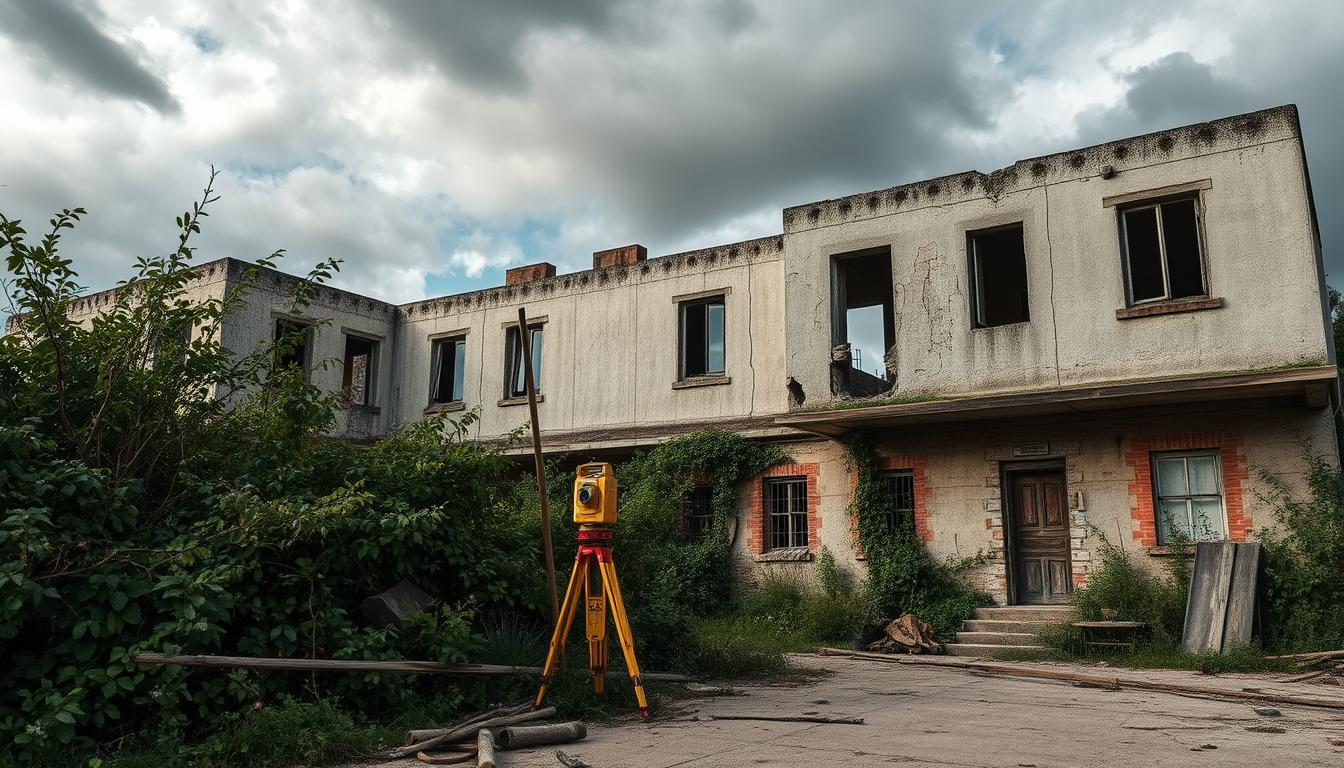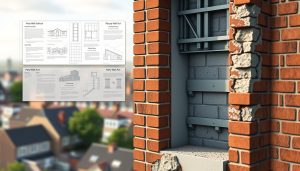A delap survey, or dilapidations survey, is a thorough examination of a property’s condition, usually performed at lease termination. It aims to uncover any damage or deterioration, compiling a detailed report for the tenant to rectify. In England and Wales, the majority of commercial leases mandate full repair and insurance (FRI) obligations, rendering a delap survey indispensable for both landlords and tenants.
For property owners, a dilapidations survey safeguards their investment. For tenants, it mitigates the risk of disputes and financial burdens. The extent of dilapidations can vary, from minor cosmetic flaws to major structural issues. An early identification through a delap survey enables both parties to plan and manage costs effectively.
This article will explore the realm of delap surveys, examining their role, methodology, and advantages. Whether you are a property owner or a tenant, grasping the significance of a delap survey is vital. It equips you with the knowledge to navigate the complexities of property assessments and dilapidations.
Key Takeaways
- A delap survey is a detailed inspection of a property’s condition, typically conducted at the end of a lease term.
- The survey helps identify any damage or disrepair, providing a schedule of dilapidations for the tenant to remedy.
- Conducting a dilapidations survey can help property owners protect their investment and tenants avoid future disputes and financial liabilities.
- The cost of dilapidations can reach significant amounts depending on the severity of defects.
- Engaging a chartered building surveyor is a common practice for obtaining quotes on dilapidation surveys.
- Regular property inspections and strategic use of a Schedule of Condition can help minimize future dilapidation costs.
Understanding the Basics of a Delap Survey
A delap survey is a professional inspection of a property’s condition, aimed at identifying damage or disrepair. It serves as a critical tool for both landlords and tenants, providing a detailed overview of the property’s state. This inspection assesses various aspects, such as doors, windows, roofs, and flooring, ensuring a thorough evaluation.
The essence of a delap survey lies in its ability to assess the property’s condition, pinpoint any damage, and compile a schedule of dilapidations. This schedule details the required repairs and their costs, aiding in negotiations between landlords and tenants. Grasping the fundamentals of a delap survey empowers property owners and tenants to safeguard their interests effectively.
Definition and Purpose
A delap survey is a meticulous process that thoroughly inspects a property’s condition. Its main objective is to identify any damage or disrepair, providing a detailed schedule of dilapidations for the tenant to address. This approach is vital for addressing dilapidation issues during the lease term, ultimately saving costs in the long run.
When Is a Delap Survey Required?
Dilapidation surveys are commonly required towards the lease’s end. Yet, it is advisable to conduct the survey well before tenants vacate. The standard timeframe for submitting dilapidation claims is about 56 days (8 weeks) post-lease termination.
Key Components of the Survey
The outcome of a dilapidation survey encompasses a detailed summary of lease breaches, obligations, costs, and repair timelines. It comprehensively covers physical property aspects, including doors, windows, roofs, and flooring. Understanding these components is essential for property owners and tenants to navigate the process effectively, protecting their interests.
| Component | Description |
|---|---|
| Property Inspection | A thorough inspection of the property’s condition |
| Schedule of Dilapidations | A document outlining the necessary repairs and associated costs |
| Lease Breaches | A summary of any breaches of the lease agreement |
The Legal Framework Behind Dilapidations Surveys
The legal framework governing dilapidations surveys is intricately complex, encompassing a variety of laws and regulations. Grasping the nuances of dilapidations survey laws is imperative for both property owners and tenants. This ensures that their rights and duties are safeguarded. The Landlord and Tenant Act 1927 stands as a cornerstone of property legislation, delineating the roles and responsibilities of landlords and tenants concerning dilapidations.
Within the realm of lease agreements, it is critical to comprehend the stipulations that define the landlord-tenant relationship. This entails a clear understanding of the tenant’s maintenance obligations and the repercussions of non-compliance. A profound grasp of dilapidations survey laws and property legislation can effectively mitigate disputes and financial burdens.
Key components of the legal framework include:
- Schedules of Dilapidations are compiled by chartered surveyors following thorough property inspections.
- A Terminal Schedule of Dilapidations is typically issued between 3 years to 18 months prior to lease expiration.
- Breaches listed in Schedules frequently encompass wear and tear or maintenance shortcomings, as defined by lease agreements.
It is imperative for tenants to scrutinise repair costs and seek legal counsel regarding dilapidations survey laws and property legislation. This ensures they are not unfairly burdened with repair responsibilities. By understanding the legal framework and their obligations under lease agreements, tenants can confidently navigate the dilapidations survey process.
| Document | Description |
|---|---|
| Terminal Schedule of Dilapidations | Issued between 3 years to 18 months before the lease expires |
| Interim Schedule of Dilapidations | Issued at any time during the lease to address immediate repair needs |
| Final Schedule of Dilapidations | Issued after a lease has expired, often including claims for lost rent |
Types of Property Requiring a Delap Survey
A Delap survey is vital for a variety of properties, encompassing commercial, residential, and industrial sites. Each property type possesses distinct attributes and needs, with a Delap survey serving to uncover possible issues and compile a detailed schedule of dilapidations.
Commercial Properties
Commercial entities, such as office buildings and retail establishments, necessitate a commercial property survey to evaluate their state and pinpoint any defects. This survey is instrumental in preventing exorbitant repair costs and averting disputes between property owners and tenants.
Residential Buildings
Residential structures, including apartments and houses, demand a residential property inspection to assess their condition and pinpoint necessary repairs. Such inspections are critical for ensuring the safety and upkeep of the property, benefiting both owners and tenants.
Industrial Premises
Industrial facilities, such as factories and warehouses, require an industrial property survey to evaluate their condition and detect any hazards. This survey is essential for maintaining the safety and regulatory compliance of the property, safeguarding the interests of both owners and tenants.
Engaging in a Delap survey is imperative for safeguarding property investments and mitigating financial risks. It is critical to enlist the services of a proficient surveyor to conduct the survey and deliver a thorough report.
The Complete Delap Survey Process
The delap survey process encompasses various stages, from survey preparation to its culmination. It commences with an exhaustive examination of the property’s documentation and lease agreements. This ensures that every detail is meticulously considered. Subsequently, a detailed property inspection process follows, where the surveyor meticulously identifies any damage or disrepair. This stage is fundamental in delivering an accurate and equitable report.
A critical element within the delap survey process is the survey preparation. This entails the compilation of all pertinent information regarding the property, encompassing its dimensions, condition, and historical background. Such data is indispensable for a thorough property inspection process. For further insights into the significance of precise reporting in dilapidations surveys, refer to dilapidations for surveyors.
The culmination of the delap survey process is the reporting phase. Here, the surveyor compiles a detailed report detailing the property’s state and any requisite repairs. This report is indispensable in delineating the extent of work necessary to restore the property to its original state.
By understanding the entire delap survey process, property owners and tenants can more effectively navigate its complexities. This ensures that all facets are adequately addressed, and the final report is both accurate and just. The delap survey process is a vital aspect of property management, underscoring its indispensable role.
Costs and Timeframes Associated with Dilapidations Surveys
Understanding the costs and timeframes of dilapidations surveys is vital for property stakeholders. The delap survey costs fluctuate based on property size, condition, and location. Typically, the expense can span from a few hundred to several thousand pounds.
The dilapidations survey prices are influenced by several factors. These include the property type, survey scope, and the surveyor’s qualifications. Selecting a qualified surveyor is critical for an efficient and effective survey. The survey timeframes also vary, often taking several days to weeks to complete.
Several factors impact the costs and timeframes of dilapidations surveys:
- Property size and complexity
- Location and accessibility
- Surveyor’s qualifications and experience
- Scope of the survey
By grasping these factors, stakeholders can better plan and budget. Engaging a reputable surveyor via us can help reduce costs. Our panel boasts over 100 years of property experience with over 20 specialists across various regions.
In conclusion, the costs and timeframes of dilapidations surveys are fundamental aspects. By selecting a qualified surveyor and understanding the influencing factors, stakeholders can ensure a cost-effective and timely survey. This approach minimizes expenses and optimizes the survey process.
| Survey Type | Average Cost | Timeframe |
|---|---|---|
| Basic Survey | £500-£1,000 | 1-3 days |
| Standard Survey | £1,000-£3,000 | 3-7 days |
| Comprehensive Survey | £3,000-£5,000 | 7-14 days |
Landlord's Perspective: Benefits and Responsibilities
As a landlord, grasping the benefits and responsibilities tied to a landlord delap survey is critical. A delap survey acts as a shield for your investment, ensuring your property’s upkeep. Regular inspections and maintenance uncover issues early, averting expensive repairs and maintaining safety and habitability for tenants.
Property owners bear the duty of maintaining their properties in good condition. A delap survey pinpoints areas needing attention, enabling timely action. This proactive approach mitigates disputes and costly repairs. It’s also vital to acknowledge tenant obligations, as they must report any issues promptly.
The advantages of a delap survey for landlords are numerous:
- Identifying issues before they escalate
- Preventing costly repairs
- Ensuring property safety and habitability
- Reducing tenant disputes

In summary, a delap survey is indispensable for landlords, providing a detailed assessment of the property’s condition. Understanding your responsibilities and the survey’s benefits ensures your investment’s protection and the property’s upkeep.
| Benefits of Delap Survey | Description |
|---|---|
| Identifying issues | Prevents costly repairs and ensures safety and habitability |
| Preventing costly repairs | Reduces repair expenses and maintains property condition |
| Reducing disputes | Prevents tenant disputes and ensures property safety |
Tenant's Rights and Obligations During a Delap Survey
Understanding your rights and obligations is critical when undergoing a Delap survey. This process, also known as a dilapidations survey, involves a surveyor evaluating a property’s condition to identify any necessary repairs. The complexity of this process necessitates tenant awareness of their rights and obligations to prevent disputes.
Before the survey commences, tenants should meticulously review their lease agreement. This ensures they comprehend their obligations. During the survey, tenants must collaborate with the surveyor, granting access to the property. Post-survey, tenants must scrutinise the report and undertake any required repairs. It is imperative for tenants to be aware of their rights, including the entitlement to a survey report copy and the right to contest any landlord claims.
Key Considerations for Tenants
- Tenants should ensure they understand their lease agreement and tenant obligations.
- Tenants should cooperate with the surveyor during the survey process.
- Tenants should review the survey report and address any necessary repairs.
In the UK, the Landlord and Tenant Act 1954 delineates the rights and duties of both landlords and tenants. UK tenants are only responsible for repairs if these are explicitly stated in their lease agreements. A Schedule of Condition Survey can mitigate a tenant’s liability by documenting the property’s condition at lease expiry. By grasping their rights and obligations, tenants can confidently navigate the Delap survey process, averting any disputes.
Common Issues Identified in Delap Surveys
A delap survey can uncover a range of problems, from structural defects to maintenance and decorative issues. These common problems can result in substantial financial burdens if not resolved promptly. Both property owners and tenants can benefit from a delap survey, as it helps identify issues before they escalate.
Common issues include wall cracks, roof damage, and faulty electrical systems. Regular property maintenance can prevent these problems. It is critical to address these concerns to avoid disputes and financial liabilities.
A delap survey can pinpoint necessary repairs and their costs, reducing complications and financial risks. By conducting a delap survey, tenants can avoid unexpected costs and disputes. They can ensure they understand their repair and maintenance responsibilities. For a detailed property condition report, consider contacting a professional surveyor, such as those at Havering Property Surveyors.
Some key issues that may be identified in a delap survey include:
- Structural problems, such as cracks in walls and damaged roofs
- Maintenance issues, such as faulty electrical systems and plumbing problems
- Decorative concerns, such as worn-out flooring and damaged walls

Identifying these delap survey issues early allows for proactive measures to be taken. This approach helps avoid disputes and financial liabilities. Regular property maintenance is essential in preventing these issues and ensuring the property’s condition remains optimal.
Choosing a Qualified Surveyor for Your Dilapidations Report
The selection of a qualified surveyor is imperative for a dilapidations report. An expert in property with deep experience in dilapidations surveys can significantly influence the outcome. Recent statistics reveal that tenants who opt for a qualified surveyor can save up to 50% on settlements. This is due to the surveyor’s ability to pinpoint issues and compile a detailed report, safeguarding the tenant’s interests.
A dilapidations report outlines current breaches and the costs for their rectification. A seasoned surveyor is adept at preparing and overseeing claims, boasting a high success rate in settling claims before the lease expires. For example, a surveyor may have managed over 150 claims for tenants, with 90% resolved before lease termination. Opting for a qualified surveyor ensures that the tenant’s interests are safeguarded and the survey is conducted with efficiency.
By choosing a qualified surveyor, tenants can guarantee a thorough and precise dilapidations report. This protects their interests and saves them financially in the long term. A qualified surveyor is vital for a successful dilapidations survey, bringing significant benefits to the outcome.
Conclusion: Making the Most of Your Delap Survey
A Delap survey is essential for property owners and tenants, serving as a detailed evaluation of a property’s state and spotting possible issues. This understanding empowers individuals to approach the survey confidently, sidestepping disputes and financial risks. Such surveys are critical for safeguarding investments and ensuring properties remain in optimal condition.
For both landlords and tenants, leveraging a Delap survey offers significant benefits. The delap survey conclusion underlines the necessity of routine property inspections. This allows property owners to tackle problems promptly, preserving the value of their assets. For tenants, the property survey benefits include the capacity to negotiate equitable terms, comprehend their obligations, and evade expensive dilapidations claims upon lease termination.
Collaborating with a skilled, dilapidations report surveyor is vital. It ensures the survey is exhaustive and precise, forming a solid foundation for decision-making and conflict resolution. With professional guidance, individuals can adeptly navigate the Delap survey’s intricacies, making decisions that safeguard their interests effectively.
FAQ
What is a Delap Survey?
A Delap survey is a critical evaluation for property owners and tenants. It assesses a property’s condition and identifies necessary repairs. This process protects investment for owners and prevents disputes and financial burdens for tenants.
What is the purpose of a Delap survey?
The primary aim of a Delap survey is to pinpoint damage or disrepair. It provides a detailed schedule for the tenant to rectify these issues. The survey encompasses an assessment of the property’s state, identification of defects, and a schedule of necessary repairs.
What is the legal framework behind dilapidations surveys?
The legal framework for dilapidations surveys is complex. It involves understanding the Landlord and Tenant Act 1927 and other relevant laws. This knowledge is vital for safeguarding the rights and obligations of both property owners and tenants.
What types of properties require a Delap survey?
Delap surveys are indispensable for various property types, including commercial, residential, and industrial. Each property type has unique characteristics and requirements. A Delap survey helps identify issues and provides a detailed schedule of repairs.
What are the stages of the Delap survey process?
The Delap survey process involves several stages. It begins with preparation, where the surveyor reviews property documents and lease agreements. The next stage is a thorough inspection to identify damage or disrepair. The final stage is reporting, where the surveyor outlines the property’s condition and necessary repairs in a detailed report.
What are the costs and timeframes associated with Delap surveys?
The costs and timeframes for Delap surveys vary. Factors such as property size, condition, and location influence these aspects. Typically, the cost ranges from a few hundred to several thousand pounds. The timeframe can range from several days to weeks.
What are the landlord’s responsibilities regarding Delap surveys?
For landlords, Delap surveys are vital for protecting their investment and ensuring maintenance. They must conduct regular inspections and maintenance. A Delap survey helps identify any issues promptly.
What are the tenant’s rights and obligations during a Delap survey?
Tenants have specific rights and obligations during a Delap survey. They should prepare by reviewing their lease agreement and understanding their obligations. During the survey, they must cooperate with the surveyor. Afterward, they should address any necessary repairs as per the report.
What are the common issues identified in Delap surveys?
Delap surveys uncover a variety of issues, from structural problems to decorative concerns. Common problems include wall cracks, damaged roofs, and faulty electrical systems. Identifying these issues allows for timely resolution, preventing disputes and financial liabilities.
How can I choose a qualified surveyor for a Delap survey?
Choosing a qualified surveyor is critical for a Delap survey. It ensures the survey is thorough and accurate. A qualified surveyor possesses the necessary expertise to identify issues and provide a detailed report.
















